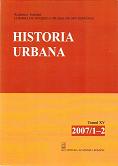Braşovul – centru financiar şi bancar al Transilvaniei la mijlocul secolului al XIX-lea
Braşov as Financial and Banking Center at the Middle of the 19th Century
Author(s): Iosif Marin BalogSubject(s): History
Published by: Editura Academiei Române
Keywords: Braşov; financial and banking center; Transylvania; financial politics; credit; commercial banks; Austrian National Bank
Summary/Abstract: The present study aims to analyze the steps Braşov followed in order to become an important financial and banking center of Transylvania at the middle of the 19th century; this analysis will present the point of view of both Vienna and its financial politics and of the regional environment that sustained the phenomenon. The capitalist form of credit was of the utmost importance in the process of economic modernization – it also represented the decisive element in urban market relations. Vienna, the most important financial centre in Central Europe from the middle of the 19th century, was soon joined by Prague and Budapest as focal points of Austria-Hungary. At the same time a series of regional centers appeared in the provinces of the empire, such as Brno, Trieste, Lvov, Braşov and others. One of the strategies the Viennese financial politics followed was to open branches of the larger commercial banks. This is the case of Braşov’s Creditanstalt für Handel und Gewerbe. Braşov was an important commercial point with rising dynamics in the ‘50s and the ‘60s as sums of 4 to 5 million florins were gained from import-export. It must nevertheless be underlined that Braşov played an important role in trading, especially outside of the Carpathians. In 1857 there were only 5 credit institutions, all having a capital of no more than a few thousands each; it is a real argument that the lack of capital and credit was a chronic reality, responsible for the lower rate of industrialization, lack of entrepreneur spirit of the urban bourgeoisie and lack of interest from the landowners who spent their money in non-productive ways. Except for the branch of the Austrian National Bank opened in Braşov in 1854 with a capital of 700000 florins (later this sum was raised to 1000000) all other institutions were organized as Sparcassen (Deposit banks) that could not supply the demand for credit – this situation led to the proliferation of money lenders and had ill-fated effects on the rural areas. The opening of the Creditanstalt’s branch in Braşov meant the beginning of modern crediting system in Transylvania and the connection to the monarchy’s financial and banking network.
Journal: Historia Urbana
- Issue Year: XV/2007
- Issue No: 1+2
- Page Range: 13-21
- Page Count: 9
- Language: Romanian
- Content File-PDF

